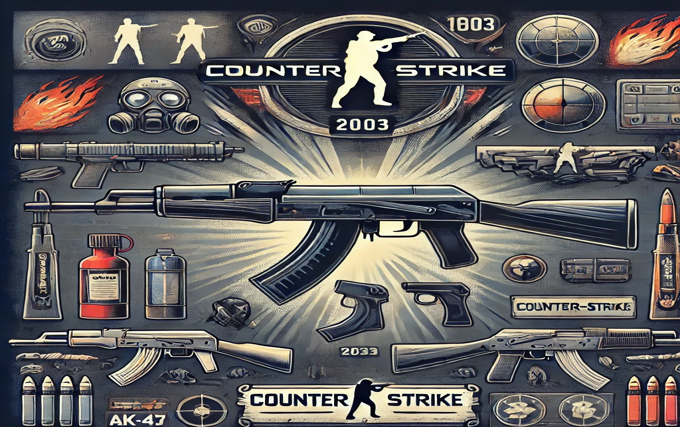Counter-Strike 1.6, released in 2003, remains a legendary installment in the world of first-person shooters. Developed as a modification of Valve’s Half-Life, it grew into a standalone title that revolutionized competitive gaming and defined the tactical shooter genre. While the gameplay mechanics, maps, and weapons were central to its success, the game icons and banners also played a pivotal role in creating a visual identity that resonated with gamers worldwide. This article explores the significance, design evolution, and cultural impact of the game’s icons and banners.
The Legacy of Counter-Strike 1.6
The Game That Changed FPS Forever
Counter-Strike 1.6 was more than just a game; it was a cultural phenomenon. It introduced players to an intense, team-based tactical experience where strategy, precision, and communication were key. Its popularity led to the birth of esports leagues and global tournaments, making it one of the most celebrated titles in gaming history.
Beyond gameplay, the visual elements of Counter-Strike 1.6—icons, banners, and branding—became symbols of its identity. These visuals not only enhanced the game’s appeal but also solidified its status as an iconic title in the gaming industry.
Game Icons: Defining Counter-Strike’s Aesthetic
What Are Game Icons?
In Counter-Strike 1.6, icons served multiple purposes. They represented weapons, equipment, team roles, and game statuses. These simple yet effective visuals provided players with instant recognition and quick decision-making capabilities during intense matches.
Design Philosophy
The design of the icons in Counter-Strike 1.6 prioritized clarity and functionality. The developers aimed to create minimalist designs that conveyed critical information without distracting players. For example:
- Weapon Icons: Each weapon had a distinct icon, from the AK-47 to the Desert Eagle. These icons were detailed enough to differentiate between firearms while maintaining simplicity for quick identification.
- Equipment Icons: Tools like flashbangs, grenades, and Kevlar vests were represented with universally recognizable symbols to ensure ease of use for players.
The Evolution of Game Banners
Role of Banners in Counter-Strike 1.6
Banners in Counter-Strike 1.6 were used to represent teams, tournaments, and community servers. They became a key element in building the game’s visual identity, particularly in multiplayer settings where players would encounter these banners frequently.
Key Features of the Banners
- Simple and Striking Designs:
Counter-Strike 1.6 banners often featured bold colors and clean designs that reflected the tactical and competitive nature of the game. - Customizability:
Players and server administrators could create custom banners, allowing for personalization and branding. This feature was especially popular in esports tournaments, where banners showcased team logos, sponsors, and event details. - Server Branding:
Community servers often displayed banners to highlight their unique features or rules, fostering a sense of community among players.
Iconography in Esports
Icons as a Branding Tool
Counter-Strike 1.6 icons transcended the game itself to become a staple of esports branding. Tournament organizers used these visuals to create cohesive themes for events, from match overlays to promotional materials.
Impact on Team Identity
For professional teams, logos and icons inspired by Counter-Strike’s aesthetic became a way to establish their brand. This trend helped differentiate teams and made them easily recognizable to fans.
Cultural Significance of Counter-Strike 1.6 Icons and Banners
A Visual Language for Gamers
The icons and banners of Counter-Strike 1.6 became a shared language for the gaming community. Whether it was the iconic crosshair icon, the familiar weapon selection visuals, or the banners representing favorite servers, these elements created a sense of belonging among players.
Influence on Modern Games
Many modern tactical shooters, such as Valorant and Rainbow Six Siege, have drawn inspiration from Counter-Strike 1.6’s approach to iconography and branding. The emphasis on clarity, simplicity, and functionality remains a standard in game design today.
Creating Custom Icons and Banners
Tools for Personalization
One of the unique aspects of Counter-Strike 1.6 was the ability for players to customize icons and banners. Tools like Photoshop and third-party editors allowed players to create visuals that reflected their style or community identity.
Popular Themes in Custom Designs
- Clans and Teams: Custom banners featuring clan names and emblems were widely used in multiplayer servers.
- Pop Culture References: Gamers often incorporated memes, movies, and music themes into their custom designs.
- Event Promotions: Banners for tournaments or charity events showcased the versatility of this feature.
Challenges in Icon and Banner Design
Balancing Functionality and Aesthetics
One of the key challenges in designing game icons and banners was ensuring they were visually appealing without compromising functionality. In high-stakes gameplay, overly elaborate designs could distract or confuse players. Counter-Strike 1.6 excelled in striking this balance.
Technological Limitations
Given the technological constraints of 2003, developers had to work with limited graphical resources. Despite this, the icons and banners of Counter-Strike 1.6 managed to leave a lasting impression, proving that good design transcends technological limitations.
The Enduring Popularity of Counter-Strike 1.6 Icons and Banners
Nostalgia in the Gaming Community
Even two decades after its release, Counter-Strike 1.6 holds a special place in the hearts of gamers. Icons and banners from the game evoke nostalgia, reminding players of countless hours spent mastering its mechanics and competing with friends.
Revival Through Mods and Remakes
The modding community has kept the spirit of Counter-Strike 1.6 alive by recreating its iconic visuals in modern versions of the game. These efforts ensure that new generations of players can experience the classic designs that defined a gaming era.
Conclusion
The icons and banners of Counter-Strike 1.6 (2003) remain a significant part of the game’s enduring legacy. Beyond their functional design, they became a visual language that resonated with players, fostering community identity and influencing the aesthetics of modern tactical shooters. These visuals, whether through weapon icons or custom server banners, added depth and character to the gameplay experience. Decades later, their nostalgic value continues to connect gamers and inspire creative expression. Counter-Strike 1.6’s visual elements remind us that great design is timeless, cementing its place as a legendary title in the history of competitive gaming.


